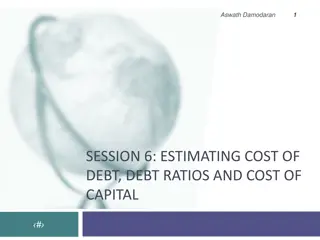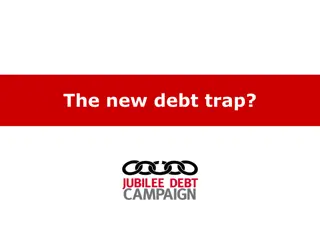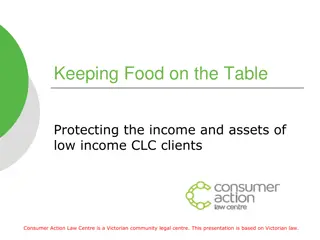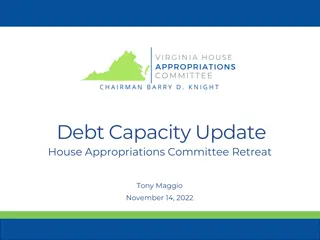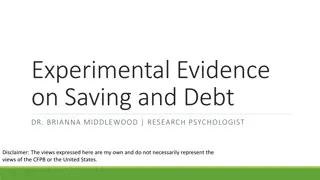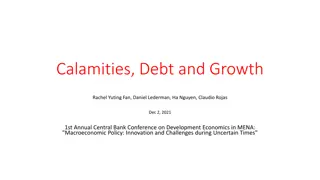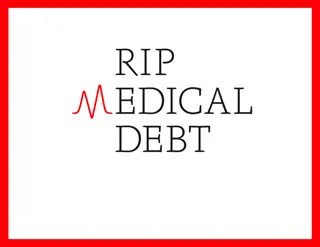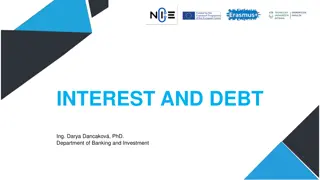Managing Debt for Economic Development in Your Community
Explore strategies for managing debt to foster economic growth in your city. Learn about types of economic development, incentives, and financial tools available to support commercial, industrial, and residential projects. Discover how TIF rebates, tax abatements, and infrastructure financing can contribute to sustainable development without straining city finances.
Download Presentation

Please find below an Image/Link to download the presentation.
The content on the website is provided AS IS for your information and personal use only. It may not be sold, licensed, or shared on other websites without obtaining consent from the author. Download presentation by click this link. If you encounter any issues during the download, it is possible that the publisher has removed the file from their server.
E N D
Presentation Transcript
Economic Development: Managing your Debt for Growth in your Community Maggie Burger, Sr. Vice President Speer Financial, Inc.
DOES YOUR CITY WANT ECONOMIC DEVELOPMENT? YES
DOES ECONOMIC DEVELOPMENT COST YOUR CITY MONEY? YES It doesn t have to break the bank
TYPES OF ECONOMIC DEVELOPMENT Commercial & Industrial Incentive for creating a new business, # of new employees Infrastructure needs to these developments Residential & Multi-Residential Infrastructure needs to development Land purchase costs
ECONOMIC DEVELOPMENT INCENTIVES COMMERCIAL & INDUSTRIAL TIF Rebate Agreements LOST Rebate Agreement GO Borrowing for Infrastructure or Grant Incentive Tax Abatement RESIDENTIAL & MULIT-RESIDENTIAL TIF Rebate Agreements Subject to Low to Moderate Income set aside Tax Abatement Limitations on Abatement of new single-family housing GO Borrowing for Infrastructure Paid with TIF collections or debt service levy
INCENTIVES TIF Rebate New valuation creates TIF increment Tax Abatement New valuation does not appear on tax rolls or is reduced for set number of years. LOST Rebate Set amount annually from total LOST collections of City Collect increment annually to rebate back to developer New business receipts, based on financials or receipts paid in by new development Commercial & Industrial sliding scale over 10 years Housing rebates may require LMI set aside Residential first $75,000 of new growth abated for up to 5 years No urban renewal or revitalization work needed Housing rebates can only be tied to infrastructure costs, not land costs/housing costs Multi-Residential up to 100% for 10 years Commercial & Industrial immediate growth in valuation Urban Revitalization work required Housing may take years of growth to maximize. Revit plan must be in place before project begins Urban Renewal Plan work required Counts against debt capacity
GENERAL OBLIGATION BORROWING Borrow for incentive grant (one time to developer) Borrow for City to build infrastructure to development; water, sewer, stormwater Debt repayment from TIF collections, debt service levy or water/sewer/stormwater revenues Establish a stormwater utility if not already done Counts against the City s debt capacity Risks in City issuing the debt City is a developer or partner in development if a GO issuance is done
DEBT CAPACITY CALCULATION 100% Valuation $109,526,378 At 5% =$5,476,318 5% OF 100% Actual Valuation use military exemption amount use regular & agricultural Total principal of GO; LOST Revenue and TIF Revenue debt counts against debt capacity Total GO outstanding $4,205,000 No Rebates outstanding Remaining Debt Capacity =$1,217,318 Approximately 22.2% Remaining in Total Debt Capacity Total aggregate amount of rebate agreement counts against, if no annual appropriation language is used Total annually appropriated amount of rebate counts against
DEBT CAPACITY City is NOT developer Rebate or annual appropriation of rebate counts against debt capacity (minimal amount) LOST Rebate has no impact on debt capacity Tax Abatement stalls the growth in valuation until abatement is completed. All debt should not exceed 80% of total debt capacity, leaving 20% for emergency borrowings City IS developer City needs to hold back 50-60% of debt capacity for development borrowings; leave 40-50% for general borrowing needs of City City should have ample (50-100% of expenses) in capital improvements fund balance to purchase land no borrowing (do not take from general fund) City should have claw back with developer in case development does not happen, City can ask for money back to pay down/off debt
RISKS TO CITY BEING DEVELOPER- GO ISSUANCE What if City borrows GO debt and the development never grows new valuation? The current residents may feel the debt burden by paying a debt service levy for debt issued GO debt payments begin immediately, even with successful development, you are 18-24 months before new valuation is available If granting to developer, only grant amounts incrementally when certain development levels are achieved City cannot collect TIF receipts to pay themselves for land purchase, only infrastructure costs on residential Did the City put infrastructure to an area that is attractive for development by another developer? If the City bought the land and gives it away how is the debt paid? Important to have cash for these purchases if you MUST buy land IS A BANK LOAN GENERAL OBLIGATION DEBT? YES YES YES!!
IDEAS SOLUTIONS- BEST PRACTICES Update or have a comprehensive plan done, see what your City s needs are Utilize Capital Improvement Planning: PLAN, PLAN, PLAN Align common stakeholders around a common vision Establish an Economic Development Incentive Policy Partner with developer, pay a portion of costs, not ALL the costs Or partner with local economic development group In partnership City is paid back first before developer Know the economic benefits of development, not just social benefits Work to save money, grow fund balances, review utility rates regularly
DISCUSSION TAKE AWAYS Debt Capacity is precious and does not grow quickly Economic Development is vital to sustaining most Cities Do not make snap decisions- PLAN Look for economic development partners Make the City s repayment of their commitment first above all partners THANK YOU Maggie Burger, Sr. Vice President Speer Financial, Inc. mburger@speerfinancial.com








